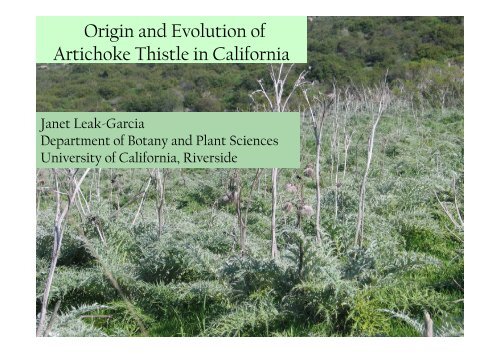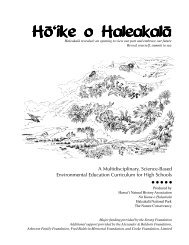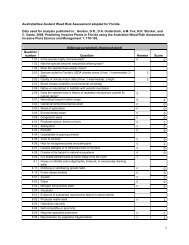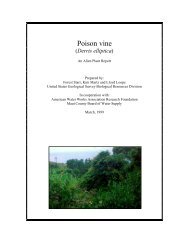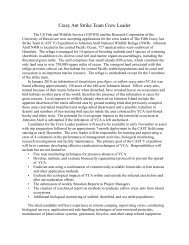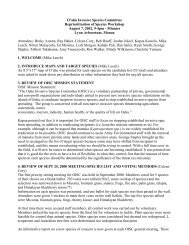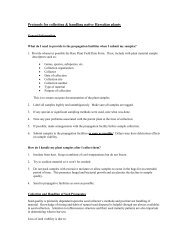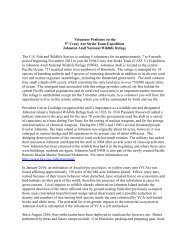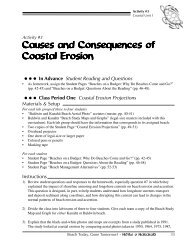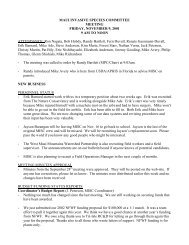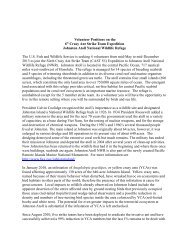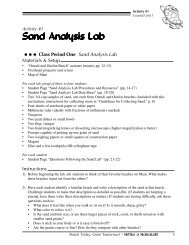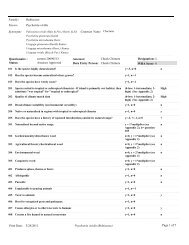Origin and Evolution of Artichoke Thistle in California
Origin and Evolution of Artichoke Thistle in California
Origin and Evolution of Artichoke Thistle in California
You also want an ePaper? Increase the reach of your titles
YUMPU automatically turns print PDFs into web optimized ePapers that Google loves.
<strong>Orig<strong>in</strong></strong> <strong>and</strong> <strong>Evolution</strong> <strong>of</strong><br />
<strong>Artichoke</strong> <strong>Thistle</strong> <strong>in</strong> <strong>California</strong><br />
Janet Leak-Garcia<br />
Department <strong>of</strong> Botany <strong>and</strong> Plant Sciences<br />
University <strong>of</strong> <strong>California</strong>, Riverside
Outl<strong>in</strong>e:<br />
ï The problem <strong>in</strong><br />
<strong>California</strong><br />
ï Questions addressed<br />
ï Chosen approach<br />
ï F<strong>in</strong>d<strong>in</strong>gs to date<br />
ï Upcom<strong>in</strong>g analyses<br />
ï What does it mean?<br />
ï Flavescens = sylvestris
scolymus<br />
(<strong>Artichoke</strong>)<br />
For the momentÖ<br />
Cynara cardunculus varieties:<br />
altilis<br />
(Cardoon)<br />
sylvestris (<strong>Artichoke</strong> thistle)<br />
Lake Co.CA
Photo credit: Joanne Heraty<br />
The Problem <strong>in</strong> <strong>California</strong>
Vary<strong>in</strong>g Degrees <strong>of</strong> Aggressiveness
Varied Morphologies
Questions:<br />
Geographic <strong>Orig<strong>in</strong></strong><br />
***<br />
Aggressive hybrid or feral crop<br />
populations?<br />
***<br />
What can the genetic structure <strong>of</strong> the<br />
<strong>California</strong> populations tell us about<br />
how or why they spread?<br />
***<br />
Is there an aggressive genotype?<br />
***<br />
Co<strong>in</strong>cident immigration<br />
<strong>and</strong> spread patterns?
Questions:<br />
<strong>Orig<strong>in</strong></strong>: Where did it come from?<br />
Are there aggressive hybrid or feral<br />
crop populations?<br />
What can the genetic structure <strong>of</strong><br />
<strong>California</strong>ís populations tell us<br />
about how or why they spread?<br />
Is there an aggressive genotype?
Sicily<br />
2006<br />
Spa<strong>in</strong>
3 Primary Studies:<br />
Qualitative traits:<br />
Sp<strong>in</strong>e characteristics<br />
Leaf characteristics<br />
Growth habit<br />
Genetic analysis:<br />
CA (pop, region), Italy, Spa<strong>in</strong>, CV<br />
Diagnostic alleles<br />
Allelic pr<strong>of</strong>il<strong>in</strong>g<br />
Phylogeographic cluster<strong>in</strong>g<br />
Population genetic structure<br />
ï Morphology<br />
ï Genetics<br />
ï Aggressiveness<br />
Quantitative traits:<br />
Growth rates<br />
Leaf density<br />
Shoot production<br />
Flower head size/production<br />
Seed production<br />
Seedl<strong>in</strong>g emergence
Experiments:<br />
ï Common garden 1: <strong>California</strong> plants +<br />
cultivars, <strong>in</strong>l<strong>and</strong> location<br />
ï Common garden 2: <strong>California</strong> + putative<br />
parent plants, <strong>in</strong>l<strong>and</strong> location<br />
ï Common garden 3: <strong>California</strong> + putative<br />
parents, coastal location<br />
ï Microsatellite analysis:<br />
13 SSR markers, average <strong>of</strong> 13 alleles each, 476<br />
<strong>in</strong>dividuals represent<strong>in</strong>g all groups.
<strong>California</strong> collection<br />
UCR October 2006<br />
Common Garden #1
UCR April 2007
UCR Summer 2006
UCR Greenhouse 2007
With<strong>in</strong> <strong>and</strong> Between Populations<br />
Seedl<strong>in</strong>g Variability
Seedl<strong>in</strong>g Regional Differences
Regional Leaf Morphology Differences
2007: Measur<strong>in</strong>g Reproductive<br />
Capabilities<br />
In <strong>California</strong><br />
Populations<br />
All heads were<br />
measured <strong>and</strong><br />
bagged for later<br />
seed retrieval
3 Primary Studies:<br />
Qualitative traits:<br />
Com<strong>in</strong>g spr<strong>in</strong>g 2008<br />
Genetic analyses:<br />
Visual analysis <strong>of</strong> allelic patterns reveals<br />
with<strong>in</strong>-population uniformity, between<br />
population diversity, particularly <strong>in</strong><br />
<strong>California</strong>.<br />
Between-group diversity <strong>in</strong> regional <strong>and</strong><br />
taxonomic groups (CA, IT,SP,CV).<br />
Italian alleles are not absent <strong>in</strong> CA<br />
5000<br />
4500<br />
4000<br />
3500<br />
3000<br />
2500<br />
2000<br />
1500<br />
1000<br />
500<br />
0<br />
ï Morphology<br />
ï Genetics<br />
ï Aggressiveness<br />
Quantitative traits:<br />
Significant differences<br />
between CA pops <strong>in</strong><br />
emergence times, ultimate<br />
plant size, leaf production,<br />
Receptacle Area Sums<br />
but not <strong>in</strong> vegetative shoot<br />
production.<br />
4700.81<br />
Aggressive populations had<br />
30% greater seed produc<strong>in</strong>g<br />
3301.04<br />
surface area than longestablished<br />
but well-behaved<br />
populations.<br />
Fast Slow<br />
p (T
Summary: What does it mean?<br />
ï <strong>California</strong>: uniformity with<strong>in</strong> <strong>and</strong> variability<br />
between populations; <strong>in</strong> the wild, <strong>in</strong> the<br />
greenhouse <strong>in</strong> a common garden <strong>and</strong> <strong>in</strong> SSR allelic<br />
distribution.<br />
ï As a group, <strong>California</strong> populations have greater<br />
variability than Spa<strong>in</strong>, Italy or the 2 cultivars.<br />
ï <strong>California</strong> populations are idiosyncratic. Many are<br />
feral hybridized or <strong>in</strong>trogressed with cultivar genes.<br />
ï <strong>California</strong>ís artichoke thistle likely has Spanish<br />
orig<strong>in</strong>s. The presence <strong>of</strong> both Spanish <strong>and</strong> Italian<br />
alleles suggest that Italian artichoke thistle may<br />
have been <strong>in</strong>troduced then genetically absorbed by<br />
a more aggressive Spanish form.
SummaryÖ<br />
ï Multiple <strong>in</strong>troductions <strong>of</strong> all sub-taxa<br />
provide an enormous amount <strong>of</strong> genetic<br />
diversity.<br />
ï Genotypes never before exposed to<br />
each other produce novel new<br />
comb<strong>in</strong>ations.<br />
ï Weedy genotype(s) emerge?
Many Thanks to:<br />
GAANN Fellowship<br />
Elvenia Slosson Foundation<br />
My Advisors:<br />
Dr. Norm Ellstr<strong>and</strong> <strong>and</strong> Dr. Jodie Holt<br />
Members <strong>of</strong> the Ellstr<strong>and</strong> <strong>and</strong> Holt labs,<br />
both past <strong>and</strong> current.
Cynara sylvestris Lamk<br />
Wild artichoke, wild cardoon, artichoke thistle<br />
Cynara cardunculus L. var. sylvestris (Lamk) Fiori<br />
Cynara sp.Taxonomy<br />
Rottenberg <strong>and</strong> Zohary 1995,1996*<br />
C. cardunculus<br />
<strong>Artichoke</strong><br />
C.cardunculus ssp. cardunculus<br />
Wild form, Italy <strong>and</strong> eastern Med<br />
Cynara scolymus L.<br />
Cultivated artichoke<br />
Cynara cardunculus L. var. scolymus (L.) Fiori<br />
Wiklund 1992<br />
Synonyms (also listed by Wiklund):<br />
C.cardunculus<br />
Cardoon<br />
C. cardunculus ssp. flavescens<br />
Wild form, Iberian, western Med.<br />
"weedy"<br />
Cynara cardunculus L. var. ferocissima = Cynara horrida<br />
Cynara cardunculus L. var. hortensis<br />
Cynara cardunculus L. var. <strong>in</strong>ermis<br />
Cynara cardunculus L. var. sativa<br />
Cynara cardunculus L. var. scolymus<br />
Cynara scolymus L. var. mutica<br />
Cynara scolymus L. var. pungens<br />
Cynara cardunculus (?)<br />
Cultivated cardoon<br />
Cynara cardunculus L. var. altilis DC<br />
* See also Harlan <strong>and</strong> DeWitt 1971


